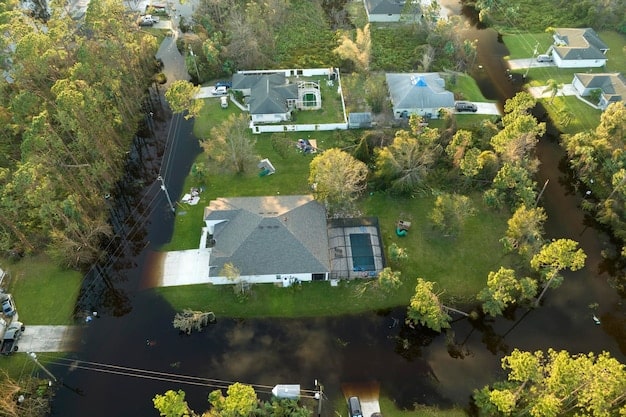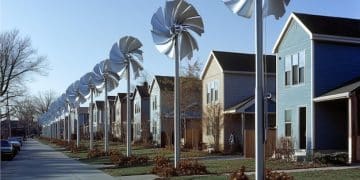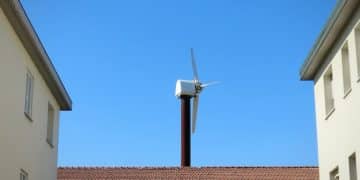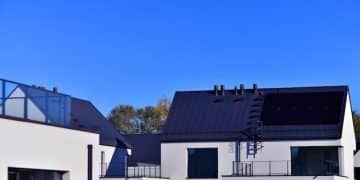Small-Scale Wind Turbines: Viable for US Homes in 2025?

Small-scale wind turbines present a potential renewable energy solution for US homeowners in 2025, offering energy independence and reduced carbon footprint, but their viability depends on factors like location, initial investment, and maintenance.
Are **small-scale wind turbines a viable option for homeowners in 2025**? As the push for renewable energy intensifies, many homeowners are considering alternative energy sources to power their homes. Let’s explore the potential benefits, drawbacks, and overall feasibility of using small wind turbines in residential settings.
Understanding Small-Scale Wind Turbines for Home Use
Small-scale wind turbines are designed to generate electricity for single homes or small businesses. These turbines are generally smaller and less powerful than the large wind farms you might see in rural areas, making them suitable for residential environments.
Components of a Small Wind Turbine System
A typical small wind turbine system consists of several key components working together to convert wind energy into electricity. Understanding these components is crucial for assessing their overall viability.
- Rotor Blades: These blades capture the wind’s energy and rotate, driving the turbine.
- Generator: The generator converts the rotational energy into electricity.
- Tower: The tower elevates the turbine to an optimal height to capture stronger and more consistent winds.
- Inverter: The inverter converts the DC electricity produced by the generator into AC electricity, which can be used to power your home or fed back into the grid.
These components are integrated to provide a seamless energy generation process, making it a potentially attractive option for homeowners looking to switch to renewable energy.

The size and capacity of these turbines vary, with typical residential models ranging from 1 kilowatt (kW) to 10 kW. The energy output depends on wind speed, turbine size, and location. The initial cost is a significant factor, but government incentives and long-term energy savings can offset this.
Factors Influencing the Viability of Small Wind Turbines in 2025
Several factors can affect whether a small-scale wind turbine is a practical choice for homeowners. Understanding these elements is essential before making any investment.
One of the primary considerations is location. Areas with consistent and strong winds are essential for optimal energy generation. The average wind speed must be high enough to justify the investment. Residential zones often have local ordinances that dictate the height and placement of such installations.
Wind Resources and Assessments
Assessing the wind resources available at a specific location is crucial. Here are some key methods for evaluating wind potential:
- On-site wind measurements: Using anemometers to collect wind speed data over a period of time.
- Wind resource maps: Consulting publicly available wind maps to estimate wind speeds in the area.
- Professional wind assessments: Hiring experts to conduct comprehensive wind studies.
These assessments provide insights into the potential energy production, helping homeowners make informed decisions.
Initial costs can vary widely based on turbine size, tower height, and installation complexity. These costs have been trending downwards, making wind energy more accessible. However, maintenance expenses, including routine inspections and repairs, should also be factored into the decision.
Advantages of Installing Small-Scale Wind Turbines
Small-scale wind turbines offer several compelling advantages for homeowners seeking to reduce their reliance on traditional energy sources.
One of the significant benefits is the potential for reduced energy bills. The electricity generated can offset or even eliminate monthly utility payments, particularly in areas with high wind speeds. These wind turbines also promote energy independence.
Environmental Benefits of Wind Energy
Using wind energy provides numerous environmental advantages, making it a responsible and sustainable choice. Consider these benefits:
- Reduced Carbon Footprint: Wind turbines produce clean energy without emitting greenhouse gases.
- Sustainable Energy Source: Wind is a renewable resource, ensuring long-term energy availability.
- Decreased Reliance on Fossil Fuels: Shifting to wind power minimizes the dependence on finite fossil fuels.
These environmental factors make wind energy an appealing alternative for environmentally conscious homeowners.

Government incentives, such as tax credits and rebates, are available at both the federal and state levels to encourage renewable energy adoption. These incentives can significantly lower the upfront investment required for installing a wind turbine.
Challenges and Considerations for Home Wind Turbines
Despite the many benefits, there are also challenges and considerations to keep in mind when thinking about installing a small wind turbine. These include noise pollution along with the impact on local wildlife.
Noise from the rotating blades can be a nuisance, particularly in densely populated areas. Careful placement and modern turbine designs can help mitigate noise issues, but it remains a concern for some homeowners. Compatibility with existing grid infrastructure is also crucial.
Grid Interconnection and Net Metering
For homeowners to fully leverage their wind turbine systems, understanding grid interconnection and net metering is essential. Here’s what you need to know:
- Grid Interconnection: Connecting the wind turbine system to the local power grid.
- Net Metering: Allowing homeowners to receive credit for excess electricity sent back into the grid.
- Regulatory Compliance: Adhering to local regulations and utility company requirements.
These elements ensure that homeowners can effectively manage their energy production and consumption.
Homeowners need to be aware of zoning restrictions and permitting requirements. Many jurisdictions have specific regulations governing the installation of wind turbines, including height limits and setback requirements.
Cost Analysis: Wind Turbines vs. Other Renewable Energy Sources
When evaluating the viability of small-scale wind turbines, consider a detailed cost analysis comparing them to other renewable energy options, such as solar panels and geothermal systems.
The initial investment for wind turbines can be higher than solar panels, especially when accounting for the costs of the turbine, tower, and installation. However, the long-term energy savings and potential grid revenue can offset this initial cost. Maintenance expenses are also a crucial factor.
Comparison with Solar Panels
A side-by-side comparison between wind turbines and solar panels can help homeowners make an informed decision. Consider these factors:
- Energy Production: Wind turbines can generate electricity day and night, while solar panels are limited to daylight hours.
- Space Requirements: Wind turbines require vertical space for the tower, while solar panels need roof or ground space.
- Environmental Impact: Both options are environmentally friendly, but wind turbines may pose a risk to birds and bats.
These comparisons can reveal which option aligns best with individual needs and circumstances.
Geothermal systems, while highly efficient, have a different cost structure. They generally require a higher upfront investment for installation. These systems are best suited for homeowners looking for consistent, year-round heating and cooling solutions.
The Future of Small-Scale Wind Turbines: 2025 and Beyond
Looking ahead to 2025 and beyond, technological advancements and policy changes are expected to further enhance the viability of small-scale wind turbines. Improved turbine designs can increase energy efficiency and reliability.
Advancements in battery storage technology will allow homeowners to store excess energy generated by their wind turbines, improving self-sufficiency. Policy incentives and regulatory frameworks will play a crucial role in encouraging the adoption of small-scale wind turbines.
Innovations in Wind Turbine Technology
Several innovations are on the horizon that could revolutionize small-scale wind turbine technology. These advancements include:
- Vertical Axis Wind Turbines (VAWTs): These turbines are more compact and can operate in turbulent wind conditions.
- Quieter Turbine Designs: New blade designs and materials reduce noise pollution.
- Smart Grid Integration: Advanced controls optimize energy production and grid interaction.
These developments promise to make wind energy more accessible and efficient for homeowners.
| Key Point | Brief Description |
|---|---|
| 📍 Location Viability | Optimal wind speeds and zoning regulations strongly impact turbine effectiveness. |
| 💰 Cost Considerations | Include initial investment, maintenance, and potential incentives for full cost overview. |
| 🌱 Environmental Benefits | Reducing carbon footprint and promoting energy independence are main advantages. |
| 🛠️ Technological Advances | Innovations promise enhanced efficiency and accessibility for homeowners. |
Frequently Asked Questions
▼
Effective small wind turbines generally require average wind speeds of at least 9-12 miles per hour. Assessing your location’s wind resource is crucial to determine if it meets this threshold for viable electricity generation.
▼
Regular maintenance includes inspecting blades for damage, checking tower stability, and servicing the generator and inverter. Professional servicing is advisable every few years to ensure optimal performance and longevity of the system.
▼
Yes, noise can be a concern. Modern turbines are designed to minimize noise, but it’s important to consider the turbine’s placement to reduce disturbances to neighbors. Regulations may also specify allowable noise levels.
▼
Government incentives come in the form of tax credits, rebates, and grants. These incentives can significantly lower the upfront investment, making wind energy more accessible and affordable for homeowners looking to switch to renewable sources.
▼
Depending on the turbine’s size, location, and energy consumption, a small wind turbine can either fully power a home or act as a supplemental source, reducing reliance on the electrical grid. Excess energy can often be sold back to the grid.
Conclusion
In conclusion, while **small-scale wind turbines** present a promising avenue for homeowners seeking renewable energy in 2025, their viability hinges on careful evaluation of location-specific factors, cost considerations, and technological advancements. With informed decision-making and favorable conditions, wind turbines can indeed be a valuable addition to the energy landscape for US homeowners.





